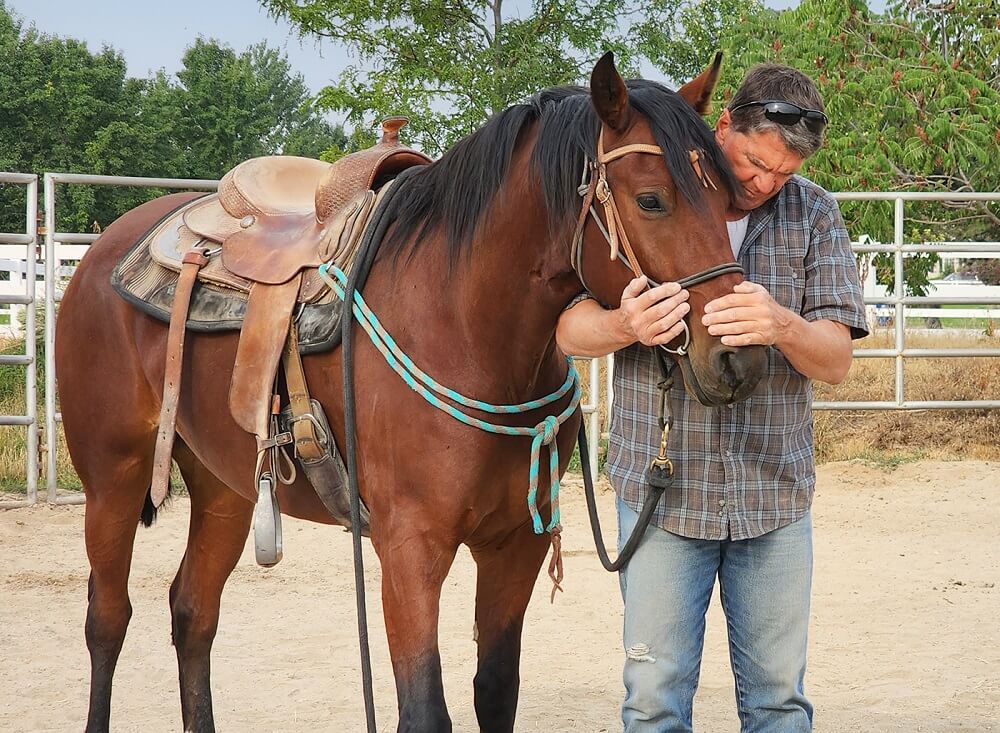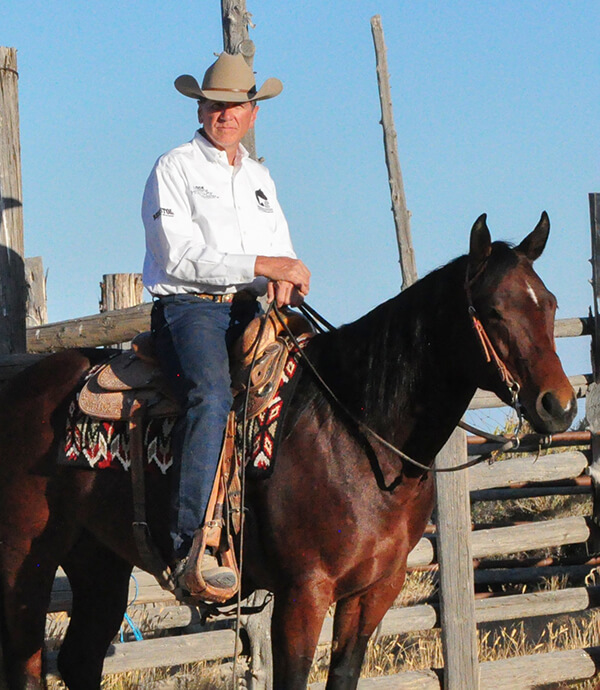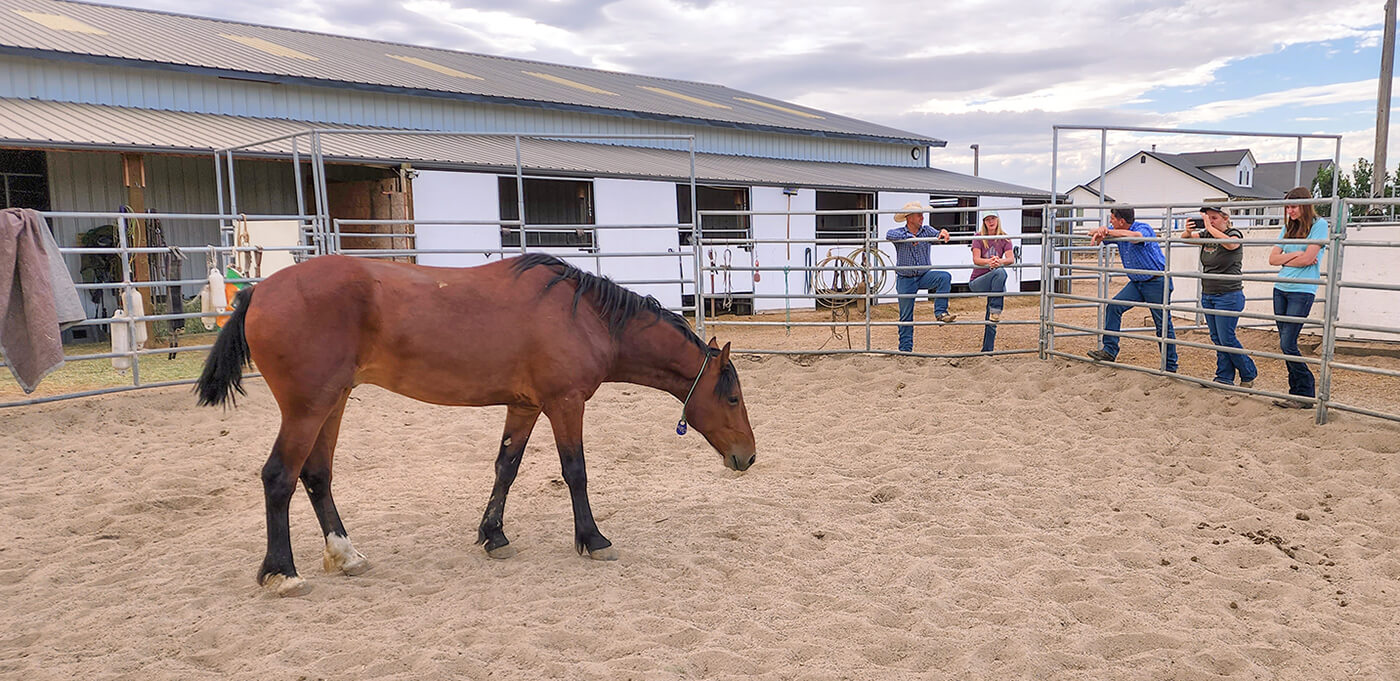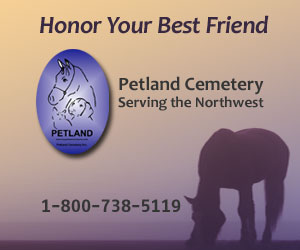From BLM Holding to Accepting a Saddle
In my first article in this series, I introduced you to Journey, my 4-year-old (formerly) wild mustang. I chose him by looking through photos of available mustangs for a 90-day mustang competition where competitors gentle and then ride wild horses. I brought Journey home in August 2022 to begin our teamwork together for the competition just three short months later. The group that sponsored the event Journey and I were in has been doing a summer event called Mustang Mania for many years. This past fall, the event I was in was a special one, called Mustang Mania Trainers Challenge.
Here, I’ll continue to share our story, but first let me explain how a person gets a wild horse from the Bureau of Land Management (BLM) holding facility into a small pen on your property. The quick answer is the BLM flags the horse (herds them by waving a plastic flag on a stick) into your horse trailer, closes the door, and wishes you good luck.
The more complete answer (but still very brief as it’s a major operation) begins with the BLM gathering horses out of a Herd Management Area where they live on range land. The main reason they conduct a gather is because there are more horses than the land can support (not enough food and/or water) so the horses are in poor body condition. Once the horses are gathered, they’re taken to a holding facility where they’re evaluated and cared for (freeze branded, dewormed, vaccinated, hooves trimmed) using humane equipment that’s adapted for wild horses.
Once a mustang is determined adoptable, the BLM makes it available to the public either through their website or mustang organizations. Interested individuals must meet specific facility requirements such as the type of fencing, size of the pen, shelter, feed, and the experience of the adopter. Potential adopters fill out paperwork and provide references which must be approved before you take a mustang home. All these requirements are on the BLM website, www.blm.gov.
When I adopted Journey, I received his BLM paperwork that showed he’d been in a holding facility for about a year and a half where he’d been freeze branded, gelded, vaccinated, dewormed, and his feet trimmed several times.
He’d never had a halter on, nor had he been willingly touched by a human. He was fairly calm as they pushed him into the trailer (for some horses this can be quite nerve-racking). He trotted up to the back of our trailer and hopped right in. We closed the door, let him settle for a few minutes, then drove home to unload him in our 65-foot round pen (with 6-foot-tall panels so hopefully he wouldn’t try to jump out). We backed our trailer up to the round pen, and he was tentative, but then hopped down and trotted into the pen with his tail up, excited. Other mustangs I’ve worked with have flown out of the trailer looking for an exit strategy. Journey trotted to the far side of the round pen and turned to face us. Horses are herd animals, and he was just separated from his herd, but our round pen is situated between two barns of horses in turnouts close by, so he could see and hear them. We positioned our round pen that way to provide reassurance for new horses.

Since I had less than 90 days, I started work with him the next morning. He wasn’t overly scared, but he wasn’t interested in having anything to do with me.
Round pens are used for starting mustangs and young horses because a horse can’t run away from you there and they won’t get trapped in a corner. I like to start with a mustang by walking around in the pen to see their reaction to my presence, to see how close they will let me get to them, and at what point they start to move away, saying, “That’s too close.” Then I play with that “bubble”, trying to gently force them to either keep moving or stand and interact with me. Journey wasn’t interested in getting close to me at all, so I played a little game of moving him from one side of the round pen to the other eventually deciding to physically shrink his bubble by removing several panels from the round pen and making it a 50-foot pen. We resumed working to develop his trust.
Journey had a hard time letting me get close enough to touch and I had to spend long, exhausting hours working with him during the dog days of summer. His lack of confidence in himself made him uncomfortable with anything new, especially me. Other mustangs I’ve started seemed to come around sooner than he did.
Since I was up against the 90-day constraint I decided to raise the stakes. After about a week of working with him and only being able to get within about 5 feet, I decided to rope him to get closer. This approach is not something to take lightly, and once you start you need to be able to finish by getting a halter and lead rope on the horse so you can remove the rope, since it’s not safe to leave a rope around the neck of a loose horse.
I got to the point where I had a halter and long lead rope (called a drag line) on him and called that good. I let him learn to step on the drag line and give to that pressure. Having a drag line made it easier to resume training each time I stepped into the pen.
Part of his training was to get him used to everything in the human world to help him transition into a safe saddle horse someday. I pushed hard to desensitize him to things like balls, tarps, ropes, blankets, pool noodles and more. We worked together 4 to 6 hours per day, at first in 20-to-40-minute sessions, then longer when he could handle it. Slowly he got used to being touched all over his body. Some mustangs are more accepting; he took his time.
With horses you must introduce things to them on both sides of their body. Their perception is different from ours so just because they can accept something on their left side doesn’t mean it is ok on the right. With patience and repetition, they learn to give to pressure and walk on a lead next to you. With each new item I brought into the round pen, we’d have to start all over with desensitizing as he would shy away, snorting. Some days it was very discouraging; I worried he might never become truly domesticated.
It takes patience to work with mustangs as you must let them figure things out. Journey required a lot of time to go through this process, and all the while the 90-day competition clock was ticking away. By this point in the competition many trainers were already riding their horses out on the trails.
Finally, the day arrived when Journey’s confidence was to the point where I could introduce him to a saddle. I started with a kid’s saddle and took things slowly but eventually I could put the saddle on and off and cinch it up. He would stand still, although for a very long time he was suspicious of the saddle and would snort if it was sitting on the fence. We did this for a couple of weeks, working up to the regular saddle that I’d ride him in.
Then it was time for me to be gone for about 10 days. We’ll pick up here in Part 3 of My Journey with “Journey” the Mustang.
Part 1 of this series: https://nwhorsesource.com/trainers-corner-what-is-a-mustang
Part 2 of this series: https://nwhorsesource.com/trainers-corner-my-journey-with-journey-the-mustang-part-2
Part 3 of this series: https://nwhorsesource.com/trainers-corner-my-journey-with-journey-the-mustang-part-3
Final – Part 4: https://nwhorsesource.com/trainers-corner-my-journey-with-journey-the-mustang-part-4
See this article in the May/June 2023 online edition:
May/June 2023

Matt Livengood is a seasoned reining and ranch riding competitor who holds judging certifications with NRHA, NRCHA, AQHA specialty, and ASHA. He teaches riders and horses about ranch riding and ranch versatility, as well as groundwork and starting Mustangs. Matt has competed in four Mustang Makeover events, reaching the finals in all four and winning both the 2017 Reno Extreme Mustang Makeover and the 2019 Mustang Madness freestyle in Cle Elum, WA.
Matt has judged numerous Extreme Mustang Makeovers, including virtual shows. He’s been an NRHA judge since 1999, judging shows across North America each year, including A and AA shows. In 2020, he judged at the AQHA World Show in both reining and ranch riding. Matt teaches and trains from his home, Sweet Pepper Ranch (sweetpepperranch.com) in Nampa, ID. Call 206-909-0511 or email [email protected].




